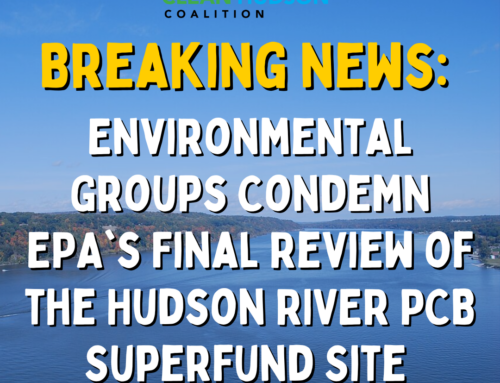Clearwater Files New Indian Point Environmental and Public Health Contention
Safe Use of Hudson River for Drinking Water Questioned
POUGHKEEPSIE, NY – Hudson River Sloop Clearwater filed a new contention with the Atomic Safety and Licensing Board last week focusing on United Water New York’s application to build a desalination plant to extract water from the Hudson River for use as municipal drinking water for Rockland County. This contention states that as a result of United Water’s application, Entergy Nuclear Operations, Inc. (“Entergy”) and the staff of the Nuclear Regulatory Commission (“NRC”) must re-assess the environmental impacts of the Indian Point Nuclear Power Plant license renewal application (“LRA”).
Clearwater’s contention faults Entergy’s environmental report included in their Indian Point LRA for failing to make a complete and thorough analysis of the impacts of license renewal upon the Hudson River as a source of drinking water and the potential for future degradation of the river as a drinking water source.
United Water New York’s proposed desalination plant, which will be located in the Town of Haverstraw, Rockland County and produce potable water from the Hudson River, will initially withdraw between 170 and 300 gallons of water per minute from the river in a pilot plant operation, but once the full-sized desalination facility is completed 10 million gallons of water per day will be extracted from the Hudson River, thus providing up to 7.5 million gallons of usable water for Rockland County.
The desalination plant, which is to be located 3.5 miles downstream and due southwest of Indian Point, will use reverse osmosis to filter water from the Hudson River, a process that does not effectively remove radioactive isotopes like tritium, cesium-137 and strontium-90—all of which are presently detected in the groundwater at Indian Point at concentrations many times the Maximum Contaminant Level (“MCL”) allowed by the Environmental Protection Agency (“EPA”).
Even though several water authorities in the mid-Hudson region already extract water from the Hudson River to meet municipal demand, the impacts of license renewal on the water quality of these water supplies are not assessed or even mentioned in Entergy’s environmental report.
“Both Entergy and the NRC staff have repeatedly dismissed the impacts of groundwater contamination because they claim no one takes drinking water from groundwater under the plant or the Hudson River into which it is flowing,” said Manna Jo Greene, environmental director at Clearwater. “They did this without considering the potential for radioactive isotopes to be transported by the river. Now that United Water has proposed treating Hudson River water for Rockland, they must reconsider their position on this.”
Because the Hudson River is a tidal estuary, it is capable of transporting potentially harmful substances upriver, as well as downriver and cross-river. Clearwater’s contention notes that the distances that radioactive isotopes or other toxic substances released from Indian Point may travel must be evaluated. Additionally, the impacts of the radioactive waste products created by the desalination process must be assessed. The fraction of the radioisotopes that can be extracted are proposed to be treated at a wastewater treatment plant not normally designed for that purpose, thus creating a more concentrated hazardous product that will require further disposal steps.





